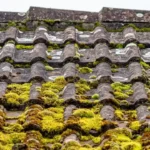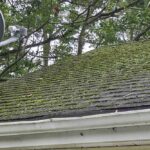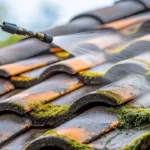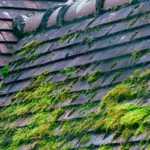Maintaining your roof is crucial for every homeowner, and one common issue many face is the growth of moss. Moss not only affects the aesthetic appeal of your home but can also lead to significant damage over time. This is where the idea of using a roof moss pressure washer comes into play. Understanding the pros and cons of this method is essential to decide if it’s the right solution for your home.

What is Roof Moss?
Moss is a small, green, flowerless plant that thrives in damp and shaded areas. When it grows on your roof, it can cause issues such as water retention and structural damage. It’s important to address moss growth promptly to preserve the integrity of your roof.
Why Use a Pressure Washer?
A pressure washer is a powerful tool that uses high-pressure water jets to remove dirt, grime, and other unwanted materials from surfaces. For roofs, it can be an effective way to remove moss and restore the roof’s appearance.
Pros of Using a Pressure Washer
1. Quick and Efficient Cleaning
One of the main advantages of using a roof moss pressure washer is the speed and efficiency it offers. Unlike manual scrubbing, a pressure washer can cover large areas quickly, saving time and effort.
2. Effective Moss Removal
Pressure washers are highly effective at removing moss. The high-pressure water jets can penetrate the moss’s roots, ensuring thorough removal and reducing the likelihood of regrowth.
3. Enhances Roof Appearance
By removing the moss, a pressure washer can significantly improve the appearance of your roof. This can enhance your home’s curb appeal and potentially increase its value.
Cons of Using a Pressure Washer
1. Potential Roof Damage
One of the biggest drawbacks is the potential for roof damage. The high pressure can dislodge shingles, remove granules, and even cause leaks if not used carefully. It’s crucial to adjust the pressure settings and use the right nozzle to minimize this risk.
2. Safety Concerns
Operating a pressure washer on a roof can be hazardous. The combination of water and height increases the risk of slips and falls, making it important to take safety precautions or hire professionals.
3. Environmental Impact
Pressure washers use a significant amount of water, which can lead to waste. Additionally, the runoff can carry moss and other debris into your garden or local water sources, potentially causing environmental harm. [For more insights on managing moss, visit this external link.]
Alternatives to Pressure Washing
If the potential downsides of pressure washing concern you, there are alternative methods to consider:
1. Manual Removal
Manually removing moss with a brush can be effective, although it is labor-intensive. It’s a safer option for delicate roofs and reduces the risk of damage.
2. Chemical Treatments
Chemical treatments can kill moss and prevent regrowth. However, they must be used with caution to avoid harming plants or wildlife. For more information on chemical options, check out this chemical guide.
3. Preventative Measures
Implementing preventative measures such as trimming overhanging branches, ensuring proper roof drainage, and using moss-resistant shingles can reduce the likelihood of moss growth.
Professional vs. DIY Pressure Washing
When considering a roof moss pressure washer, homeowners must decide whether to hire professionals or attempt a DIY approach.
Benefits of Hiring Professionals
Professionals have the experience and equipment to safely and effectively clean your roof. They can assess the condition of your roof and adjust their techniques accordingly.
DIY Considerations
For those who prefer a DIY approach, renting a pressure washer can be cost-effective. However, ensure you have the necessary skills and safety equipment before attempting the task.
Long-Term Roof Maintenance
After pressure washing, maintaining your roof is crucial to prevent moss regrowth. Regular inspections and cleanings, along with addressing any roof damage promptly, can extend the life of your roof. [For tips on maintenance, see this maintenance guide.]
Addressing Common Concerns
1. Moss Regrowth
Even after pressure washing, moss can return if conditions are favorable. To minimize regrowth, consider applying a moss-inhibiting treatment. [Read about moss regrowth here.]
2. Impact on Pets
Concerns about the safety of pets are common when using chemical treatments. Opt for pet-safe products or consult with a professional to ensure the safety of your furry friends. [More on pet safety here.]
3. Leaks and Damage
If pressure washing causes leaks, its essential to address them immediately to prevent further damage. [Learn more about leaks here.]
Conclusion
Using a roof moss pressure washer can be an effective solution for removing moss, but it’s important to weigh the pros and cons carefully. Whether you choose to hire a professional or tackle the job yourself, understanding the risks and benefits will help you make an informed decision that best suits your home and circumstances.

FAQ
1. Can pressure washing damage all types of roofs?
Not all roofs are equally affected by pressure washing. Older roofs or those with damaged shingles are more susceptible to damage. It’s crucial to assess the condition of your roof before proceeding.
2. How often should I pressure wash my roof?
The frequency depends on your local climate and the amount of shade your roof receives. Generally, every few years may be sufficient, but regular inspections can help determine the best schedule.
3. Are there eco-friendly alternatives to pressure washing?
Yes, there are eco-friendly options such as vinegar or baking soda solutions, which can be less harmful to the environment while still being effective at removing moss.
This article contains affiliate links. We may earn a commission at no extra cost to you.








